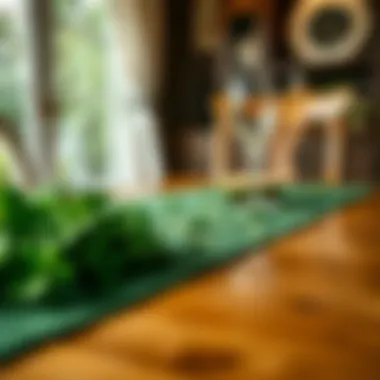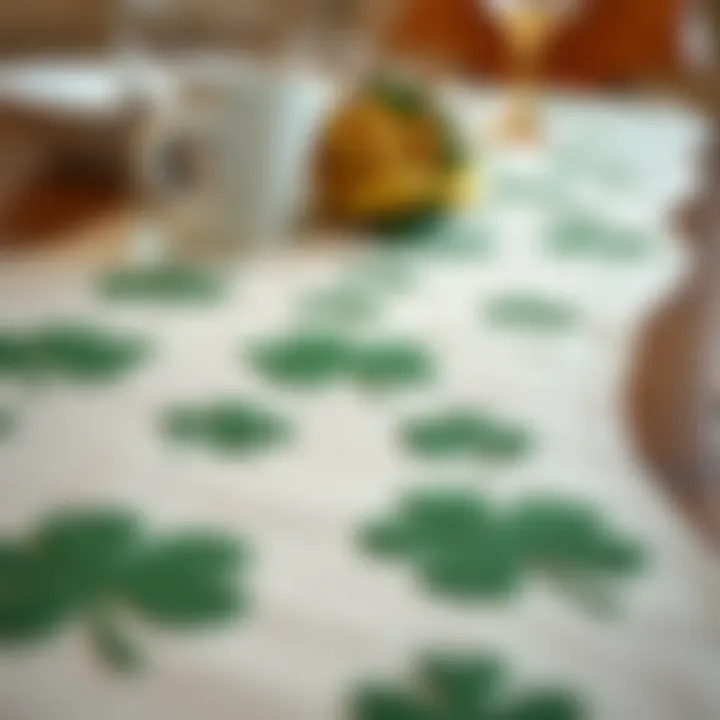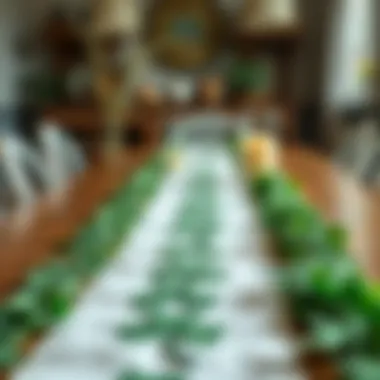Exploring the Shamrock Table Runner in Home Decor


Intro
The shamrock table runner stands out as a compelling intersection of craftsmanship and visual appeal. These decorative pieces, often adorned with intricate patterns and hues of green, have roots that trace back centuries, deeply intertwined with Irish culture. The table runner is more than just an accessory; it serves as a canvas for artistic expression and a touch of heritage, making it a notable addition to home decor.
As one fondly drapes a table with a shamrock runner, it brings forth a sense of warmth and festivity. It has the power to transform an ordinary dining setting into one that is inviting and rich in cultural significance. With periodic celebrations such as St. Patrick's Day, the allure of the shamrock takes center stage, making it a seasonal staple that goes beyond mere decoration. Not only does it link decor to broader cultural narratives, but it also provides an opportunity for personal expression in home styling.
By exploring the evolution of shamrock table runners, this article will uncover their historical worth, their role in various festivities, and even delve into practical considerations for selection and upkeep. We'll also present DIY methods to craft your own, offering creative styling ideas while taking into account ecological considerations. For those who aim to infuse their living spaces with charm and story, the shamrock table runner presents an enriching opportunity.
Preamble to Shamrock Table Runners
The shamrock table runner is more than just a decorative piece; it embodies tradition, artistry, and cultural significance. This article aims to shed light on the importance of shamrock table runners in contemporary home decor, focusing on the various layers of meaning they carry.
Definition and Purpose
A shamrock table runner serves a distinct and practical function, primarily as a decorative accessory laid across a table. These pieces can vary in size, material, and design, tailored to complement various occasions and settings. Besides their aesthetic appeal, they possess an intrinsic purpose: to protect the surface of a table while enhancing its visual allure. They bring a vibrant touch to dining setups, festive gatherings, or casual family dinners, offering versatility that appeals to a wide audience.
More than mere functional objects, these table runners can convert a bland tabletop into an inviting focal point. Designers and stylists often opt for shamrock motifs during specific seasons, particularly around St. Patrick’s Day, evoking a sense of celebration and gathering. Hence, the shamrock table runner stands out as a quintessential element of decor that marries form and function beautifully.
Cultural Significance
The shamrock carries deep cultural roots, primarily within Irish history, representing not just good luck but also symbolizing faith, hope, and love. Originating from the Gaelic word "seamróg," the three-leaved plant has played a crucial role in folklore, often associated with St. Patrick, who reportedly used it to explain the concept of the Holy Trinity.
As such, shamrock table runners are often intertwined with memories of family gatherings, Irish celebrations, or even everyday life in Irish communities. They can spark conversations about heritage and identity, weaving personal stories with the broader cultural narrative of Ireland and the Irish diaspora.
Moreover, using a shamrock table runner during festive occasions creates an ambiance charged with tradition, serving as a bridge between past and present. In homes, they might foster a sense of belonging, inviting people to not only appreciate the beauty of the design but also its story.
"A table runner, especially one adorned with shamrocks, transforms the mundane into a celebration of both craft and culture."
Historical Context
Understanding the historical context of shamrock table runners affords a layer of appreciation that goes beyond mere aesthetics. It bridges the gap between design and cultural significance, revealing the depths of meaning hidden within this decorative piece. The symbolic nature of the shamrock itself tells stories of heritage, while the evolution of table runners reflects changing tastes and the ways in which we celebrate our lives. This context not only serves to enhance our enjoyment of these items but also highlights the craftsmanship involved in their creation.
Origins of the Shamrock Symbol
The shamrock has traditionally been linked to Celtic mythology, embodying a connection to the earth and the cycles of nature. Its three leaves have led some to associate it with the Holy Trinity, which emphasizes its spiritual importance in Irish culture. The symbol was often used by Irish saints and became a vital element in promoting Irish nationalism, especially during the 18th and 19th centuries.
Used in celebrations like St. Patrick's Day, the shamrock represents not just a good fortune but also a sense of belonging and identity. When seen on table runners, it invites a multitude of interpretations. For example, in homes, a shamrock table runner might signify a welcoming environment laden with memories of family gatherings or festive occasions. As the saying goes, "a shamrock for luck, a table for stories."
Furthermore, this versatile plant appears across various forms of art, including textiles, showcasing its transition and adaptation through time. The revival of interest in traditional Irish crafts in the 20th century led to a resurgence of shamrock motifs in modern design, intertwining the past with contemporary tastes.
Evolution of Table Runners
Table runners have come a long way from their humble beginnings. Initially designed for practical purposes, such as protecting table surfaces or catching spills, they have transformed into essential decorative elements that reflect personal tastes and serve functional roles. Historically, table runners made their debut in European households during the medieval period, primarily made from linen or cotton. Their primary function was straightforward, but over the centuries, they began to evolve into intricate pieces of art.
In the Victorian era, the use of decorative table runners flourished, showcasing elaborate patterns and vibrant colors. Fabrics turned more sumptuous, incorporating delicate lace and embroidery, thus allowing for personalization. By the 20th century, table runners became symbols of hospitality. The trend carried into modern times, where various styles can be found, from minimalistic to extravagantly embellished.
The incorporation of the shamrock into table runner designs marks significant intersections of history and artistry. Today, these runners are not just a practical addition; they are celebrations of cultural heritage. They bring forth nostalgia while inviting conversation, making them must-have items for any gathering or celebration.
"A table runner, especially one adorned with a shamrock, is more than an accessory; it's a conversation starter, a bridge to our ancestors who cherished gatherings just like we do."


In drawing connections to both the past and modern aesthetics, shamrock table runners reflect how our celebrations intertwine with our identities. With every stitch and design, they serve as reminders of where we come from and the stories we hold dear.
Design Variations
Design variations play a fundamental role in the appeal and functionality of shamrock table runners. They not only enhance the aesthetic value of a space but also allow for a personalized touch that reflects the owner's style and the occasion at hand. By exploring various materials, patterns, and color schemes, one can truly make this decorative element a standout piece in any setting.
The interplay of different design variations can bring about unique benefits. For instance, using different textiles can affect the look and feel of the table runner. A linen shamrock runner may convey elegance and simplicity, while a vibrant cotton version might speak to a more casual and playful atmosphere. Understanding these nuances can assist stylists, designers, and retailers in making educated choices that resonate with their target audience.
Materials and Textiles
When it comes to materials and textiles, the options for shamrock table runners are vast. Common choices include cotton, linen, polyester blends, and even burlap, each offering distinct characteristics that can influence the overall execution of a table setting.
- Cotton: Known for its versatility, cotton can be easily printed or dyed, making it ideal for vibrant shamrock patterns. It’s also relatively easy to clean, thus suitable for everyday use.
- Linen: If elegance and a refined look are desired, linen is an excellent option. It drapes beautifully, though it may require more care to maintain its appearance.
- Burlap: For those who embrace a rustic vibe, burlap lends an earthy touch. This material often pairs well with natural decor elements, enhancing a warm, inviting environment.
By choosing the right material based on the intended use and environment, one can create not just a table runner but a vital component of the decor.
Patterns and Colors
The patterns and colors of shamrock table runners are where creativity shines. Traditionally associated with St. Patrick’s Day, the shamrock motif symbolizes luck and prosperity. However, there’s more to explore in terms of colors and designs.
One can find shamrock patterns ranging from classic green hues to more modern interpretations incorporating pastels, bold colors, or even monochrome palettes. Here are a few notable considerations:
- Traditional Green: Staying true to the classic shamrock color can respect cultural roots while celebrating festive occasions.
- Mixed Patterns: Merging shamrocks with other motifs, such as florals or geometric designs, can create an innovative look that breaks away from the norm.
- Neutral Palette: For a subtler approach, opting for understated colors like beige or soft gray can allow the shamrock design to blend seamlessly into a more diverse aesthetic.
Contrast can also play an essential role; bright shamrock designs against dark backgrounds can amplify the visual intrigue of a table setting, drawing eyes immediately to the runner.
Stylish Combinations
Creating stylish combinations with a shamrock table runner means considering the entire table setting. A runner’s synergy with dishes, cutlery, and even floral arrangements creates a captivating tableau. Here are some ideas that can elevate the overall effect:
- Layering Textiles: Use placemats or tablecloths beneath the shamrock runner to provide texture and depth. Opt for complementary colors instead of matching ones to keep the aesthetic fresh.
- Seasonal Touches: Integrating seasonal decor items, like pumpkins in autumn or flowers in spring, alongside the shamrock can create a dynamic, year-round appeal.
- Varying Heights: When placing centerpieces, think about height variation. Short florals with a tall candle can create a visual hierarchy that accentuates the beauty of the table runner.
Remember, the key to successful design is balance. Too many competing elements can distract from the main piece.
Selecting the Right Shamrock Table Runner
Choosing the right shamrock table runner goes beyond mere aesthetics; it’s about harmonizing the beauty of the piece with practical realities. A well-selected table runner can transform an ordinary meal into a festive gathering, providing a backdrop that enhances the overall atmosphere of the event. As holidays and celebrations roll around, many lean towards themed decor, and a shamrock table runner often fits right into that vision. But how do you ensure you’re making the right choice?
One crucial aspect to consider is the size and shape of the runner. A table runner that’s too small can seem lost on a grand table, while one that’s too large can overwhelm the space or push decor items off the edge—something no one wants. It’s essential to measure your table dimensions accurately. Whether it's rectangular, square, or round, understanding the proportions will lead you to a selection that brings balance. Generally, a runner should hang over the edges of the table, at least six inches on either side, to make a visual statement without going overboard. Don’t shy away from experimenting with unusual shapes as well; placing a round runner on a square table can create a visually intriguing contrast that captures attention.
Equally vital to the selection process is matching decor styles. The shamrock motif inherently brings about a certain vibe—often associated with Irish culture, luck, and springtime freshness. However, pairing it with the right style at home is key. For instance, if your design aesthetic leans towards modern minimalism, a simple green and white pattern might work beautifully. In contrast, if you have a rustic farmhouse look, a more vibrant, textured runner could amplify the cozy ambiance. Consider other decor elements in your dining area—like the color palette of the walls and complementary items—before making a final choice. This cohesion will create a pulled-together look that delights the eye.
"The magic is in the details; a well-chosen table runner doesn’t just cover the table, it tells the story of your gathering."
Also, keep in mind that versatility can be a game-changer. Selecting a shamrock runner that can easily transition from festive occasions to everyday use allows for greater flexibility. Look for materials that resist stains and wear—this means your lovely runner can endure the hustle and bustle of family dinners or holiday parties without losing its charm.
Ultimately, selecting the right shamrock table runner wraps together aesthetic appeal and practical functionality. Thoughtful consideration of size and decor harmony will elevate any dining experience.
DIY Shamrock Table Runner Ideas
Creating your own shamrock table runner not only adds a personal touch to your decor but also allows you to engage in a rewarding crafting process. The process of making a DIY shamrock table runner can blend creativity with practicality, transforming simple fabrics into stunning decorative pieces that reflect both your style and your appreciation for cultural significance.


Crafting from Scratch
Making a shamrock table runner from scratch presents a satisfying opportunity to exercise your creativity. First, choose your fabric; linen and cotton are popular choices due to their durability and ease of handling. However, consider textures that complement the festive atmosphere—perhaps a soft velvet for a touch of luxury or a rustic burlap for a more laid-back vibe.
- Gather Supplies: You'll need fabric, a sewing machine (or needle and thread), fabric scissors, and any embellishments like ribbons or sequins.
- Cut the Fabric: Measure your table length, adding extra for draping on the sides. Cut your fabric accordingly. A runner usually ranges from 12 to 16 inches in width, depending on your personal preference.
- Design Elements: For a shamrock design, you can either print or stencil the shape onto the fabric. Templates can be hand-drawn or purchased. This is where you let your artistic flair shine—hand-embroidered shamrocks offer a lovely, tactile finish.
- Sewing: If you’re comfortable with a machine, sew around the edges to prevent fraying. If you're more of a hand-sewing enthusiast, a simple whip stitch will work wonders.
- Finishing Touches: Iron the fabric once completed to enhance the appearance of your runner. Add some embellishments for a personal touch—perhaps some golden thread accents or beaded decor for that extra sparkle.
DIY crafting doesn’t have to be daunting; at its heart, it’s about enjoyment and self-expression.
Upcycling Existing Textiles
Upcycling is an eco-conscious approach to decor that breathes new life into fabric pieces you may already own. If you have old tablecloths, shirts, or skirts, consider turning them into charming shamrock table runners. This approach not only reduces waste but also makes for intriguing conversation starters.
- Select Donor Textiles: Choose fabrics with designs or colors that would work well in a shamrock-themed setting. Vintage prints or even plain greens can make stunning designs when paired thoughtfully.
- Prepare the Fabric: Wash and iron your textiles to ensure they’re clean and smooth. This sets the stage for a polished final product.
- Design Planning: You can use a large piece as the base runner and stitch on smaller patches shaped like shamrocks made from other fabrics. This method allows for an artistic quilt-like pattern, making the final piece unique.
- Sew the Pieces: Carefully sew the shamrock patches onto the base runner, layering them in a way that feels balanced. If you’re feeling adventurous, you could even mix in contrasting patterns for an eclectic vibe.
- Finishing Up: Once assembled, don’t forget to give it a good press with an iron. Ensure all seams are neat and tidy, which is vital for a professional look.
Adopting upcycling not only contributes to sustainability but also tells a story through your home decor, creating a warm and inviting atmosphere that mirrors your personality.
Styling Tips for Shamrock Table Runners
Shamrock table runners are more than just decorative pieces; they can transform the ambiance of any setting. When it comes to styling, understanding the nuances can greatly enhance their appeal. A well-thought-out arrangement not only brings out the beauty of the runner but also complements the overall decor of the space.
Why Styling Matters
Incorporating a shamrock table runner into your decor can set the stage for special gatherings or even casual get-togethers. The right styling can evoke feelings of warmth and celebration, making the environment inviting. Whether you’re preparing for a St. Patrick’s Day feast or simply want to add a dash of charm to your dining area, the smart use of colors, textures, and arrangements can amplify the visual impact while reflecting your personal taste.
Setting the Table for Special Occasions
When planning for significant events, it’s crucial to consider how a shamrock table runner can tie the whole theme together. Here are some tips:
- Complementary Colors: Utilize tableware and decorations that harmonize with the shades of green in the shamrock runner. Gold or ivory accents can enhance elegance.
- Layering Textures: Combine your shamrock runner with linen tablecloths or placemats for an added dimension. Mix smooth and rough textures to create visual interest.
- Centerpieces: Consider floral arrangements featuring white or yellow flowers that contrast with the green. A small, vibrant bouquet can draw the eye without overpowering the runner’s design.
- Lighting: Soft lighting, possibly from candles, can lend a cozy feel. It’s often the quieter elements that elevate the overall aesthetic.
A well-styled table isn’t just about aesthetics; it sets the mood for conversation and connection.
Everyday Use and Casual Settings
Not all occasions call for lavish settings. Shamrock table runners can also add a touch of cheer to everyday dining. Here’s how you can style them casually yet beautifully:
- Mix and Match: Feel free to blend patterns. Pair your shamrock runner with simple dishware or mix it with other floral prints to create an eclectic vibe.
- Casual Centerpieces: Use mason jars or simple bowls filled with fruits such as lemons or limes for an organic touch. This creates a refreshing look that feels welcoming.
- Functional Decor: A shamrock runner can also be used in other spaces, like on coffee tables or kitchen counters. Add a few cookbooks or decorative trinkets to keep it functional yet stylish.
- Seasonal Swaps: Don’t forget, you can interchange with similar runners for different seasons. Instead of a shamrock, consider one with daisies for spring, keeping your decor fresh.
Care and Maintenance
Taking care of your shamrock table runner may not be the first thing that jumps to mind when you think about decor, but paying attention to this aspect is crucial for enhancing the longevity and aesthetic allure of your piece. Proper care can keep colors vibrant and fabric intact, ensuring that your runner serves its purpose beautifully for years to come. Plus, a well-maintained table runner can elevate your dining experience, making even the most ordinary meals feel special. Let’s break down some essential cleaning techniques and storage recommendations that align with the maintenance of your shamrock table runner.
Cleaning Techniques
When it comes to cleaning your shamrock table runner, the method may vary based on the material used. Different fabrics—be it cotton, linen, or synthetic blends—have their unique requirements. Here are some practical strategies:
- Read Labels: Always begin by checking the care label. This small piece of fabric provides valuable insights into how to treat your runner properly.
- Spot Cleaning: For minor stains, a quick fix can often be done at home. Gently dab the stained area with a soft cloth and a mix of mild detergent and water. Avoid harsh scrubbing, as that could damage the fibers.
- Gentle Wash: If the label permits machine washing, opt for a gentle cycle with cold water. Using a washing bag can provide extra protection if your runner has delicate embellishments.
- Air Dry: Never toss your table runner into a dryer. Hanging it to air dry helps preserve its shape and colors. For ironing, use a low heat setting and a protective cloth to avoid any direct heat damage.
"Caring for your shamrock table runner not only extends its lifespan but also contributes positively to your overall table decor, keeping your home vibrant and welcoming."
Storage Recommendations


The way you store your shamrock table runner can significantly influence its condition when you decide to display it again. Here are some simple yet effective storage tips:
- Avoid Folding: Folded fabric can create creases and potential damage. If possible, roll your table runner instead to keep it smooth.
- Cool, Dry Place: Store your runner in a cool, dry location. Excess moisture can lead to mold or mildew, especially if the fabric is natural.
- Breathable Containers: Use breathable fabric bags or boxes instead of plastic containers. This helps to prevent the accumulation of humidity, which can do serious harm over time.
- Keep Away from Sunlight: Direct sunlight can fade colors, so it’s best not to store your table runner in a place where it could be exposed.
By keeping these care and maintenance tips in mind, you can protect your shamrock table runner from wear and tear. Not only will this ensure it continues to enhance your decor, but it also allows you to enjoy it fully during various occasions, from intimate dinners to festive gatherings.
Sustainable Practices in Table Runner Production
In today’s world, where environmental consciousness is becoming ever more paramount, the notion of sustainability in table runner production cannot be overlooked. As decorators and consumers, there's a growing responsibility to seek out options that do not just enhance our living spaces but also support the planet. Shifting towards sustainable practices enables us to reduce our environmental footprint, ensure responsible sourcing, and foster a healthier ecosystem. With a myriad of options to choose from, focusing on sustainability offers dual benefits: aesthetic enhancement and ecological preservation.
Choosing Eco-Friendly Materials
When selecting materials for shamrock table runners, the choice of fabric can drastically affect the sustainability of the product. Opting for organic cotton, hemp, or linen sourced from sustainable farms rather than conventional cotton or synthetic textiles demonstrates a clear commitment to eco-friendliness.
For instance, organic cotton is cultivated without harmful pesticides, preserving biodiversity and soil quality. Hemp, on the other hand, grows quickly and thrives in poor soil, needing minimal water. The longevity of these materials often surpasses that of their unsustainable counterparts, providing more than aesthetic value to your home environment.
- Here are a few materials worth considering:
- Organic Cotton: Grown without chemicals or synthetic fertilizers.
- Hemp: A low-impact fiber that is biodegradable and durable.
- Recycled Polyester: Made from repurposed plastic bottles, reduces waste.
Implementing a conscious choice of textiles enables not only for a beautiful decoration but also upholds a commitment to the environment. As those who are involved in crafting or designing explore these materials, they partake in a broader movement, supporting practices that protect both people and the planet.
Supporting Local Artisans
The act of selecting shamrock table runners crafted by local artisans is another crucial component of sustainable practices. By choosing to support local craftspeople, consumers directly influence their immediate economic community and often engage with makers who adhere to ethical production methods. This not only strengthens local economies but also reduces the carbon footprint associated with shipping goods over long distances.
When local artisans craft these table runners, they often utilize traditional techniques and materials that are more sustainable compared to mass-produced counterparts. Besides preserving craftsmanship, it also nurtures cultural heritage, giving each piece a story, an essence that commercial products often lack.
- Benefits of supporting local artisans include:
- Reduced Environmental Impact: Less transportation means lower emissions.
- Enhancing Local Culture: Each piece carries cultural significance and uniqueness.
- Stronger Community: Our support helps keep artisans in business and innovative.
Supporting local artisans enriches both your home decor and the fabric of your community, fostering an environment of collaboration and creativity.
In summary, by focusing on eco-friendly materials and supporting local artisans, not only can we elevate our aesthetic surroundings with shamrock table runners but also contribute to a more sustainable and ethical environment. Such choices reflect a commitment not just to beauty, but to stewardship of the earth and its communities.
Frequently Asked Questions
The Frequently Asked Questions section serves a vital role in shedding light on the common inquiries that arise when considering shamrock table runners for any decor. This segment not only helps demystify intricacies involved in choosing, maintaining, and optimizing the use of these decorative pieces but also enriches the reader's understanding of their applications.
Addressing these prevalent questions aids in tailoring options that fit specific needs, providing clarity on sizing, materials, and style compatibility. By easing the decision-making process, individuals can ensure their choices resonate well with both aesthetic appeal and functional requirements. Let’s delve deeper into two of the most pressing inquiries.
How do choose the perfect size?
Selecting the right size for a shamrock table runner can greatly influence how it enhances the dining space. Here are some crucial considerations:
- Table Dimensions: Measure your dining or display table length and width. Ideally, the runner should extend beyond the edges of the table by at least six inches on each side.
- Purpose and Style: Consider the occasion. For formal dinners, a longer runner can create a dramatic effect, while casual settings might benefit from a more modest length.
- Table Shape: Round tables often pair well with a circular or oval runner, while rectangular tables call for long, straight runners.
- Layering: For a more layered look, use multiple runners of varying lengths or widths. This not only adds texture but can also help in defining different areas of your table layout.
"The right size can anchor the entire table setting, making it feel cohesive."
What are common materials used?
The materials used for shamrock table runners greatly affect their durability, appearance, and maintenance. Here are some popular choices:
- Cotton: A versatile option that offers breathability and comfort, cotton runners are easy to wash and come in various designs.
- Linen: Known for its elegant drape, linen presents a more upscale look and natural texture, though it may require more care to maintain.
- Burlap: Often chosen for rustic decor, burlap brings a natural, earthy vibe but may be rougher against the surface of the table.
- Synthetic Fabrics: Nylon or polyester blends provide durability and stain-resistance, which can be ideal for environments prone to spills or frequent use.
By keeping these considerations in mind, one can select a shamrock table runner that not only meets size requirements but also complements the aesthetic of the space.







